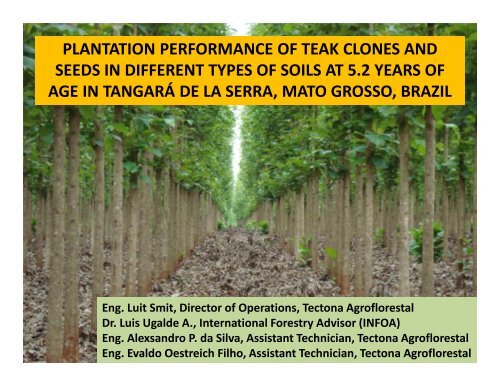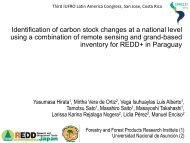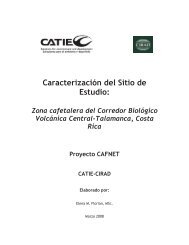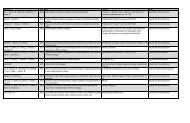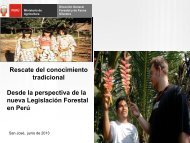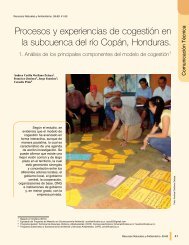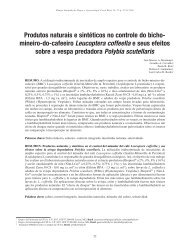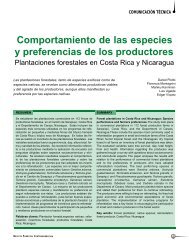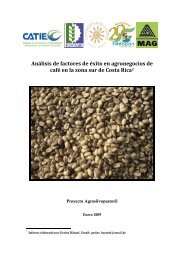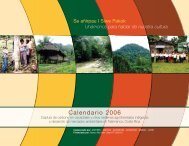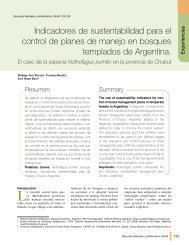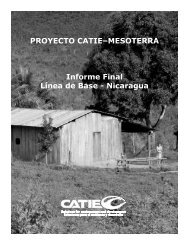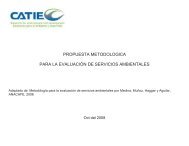and clones - Catie
and clones - Catie
and clones - Catie
Create successful ePaper yourself
Turn your PDF publications into a flip-book with our unique Google optimized e-Paper software.
PLANTATION PERFORMANCE OF TEAK CLONES AND<br />
SEEDS IN DIFFERENT TYPES OF SOILS AT 5.2 YEARS OF<br />
AGE IN TANGARÁ DE LA SERRA, MATO GROSSO, BRAZIL<br />
Eng. Luit Smit, Director of Operations, Tectona Agroflorestal<br />
Dr. Luis Ugalde A., International Forestry Advisor (INFOA)<br />
Eng. Alexs<strong>and</strong>ro P. da Silva, Assistant Technician, Tectona Agroflorestal<br />
Eng. Evaldo Oestreich Filho, Assistant Technician, Tectona Agroflorestal
- When <strong>and</strong> where <strong>clones</strong> are a commercial alternative ?<br />
- A clone is not synonymous of superiority until it is<br />
demonstrated.<br />
L. Uglade. Oct.2011
Clones in Costa Rica planted at 5 years of age (left), the<br />
trees are well shaped <strong>and</strong> have good thickness (right) with<br />
DBH from 18-20 cm <strong>and</strong> total height of 14-15 meters in<br />
Ecodirecta, San Carlos, Costa Rica (2500 – 3000 mm/year).<br />
L. Uglade. Oct.2011
Left: 4 block progeny trial, consisting of 28 families <strong>and</strong> one control plant<br />
originally at a spacing of 3x3 meters. Engineer, P. Gamboa, shows the best trials at<br />
8 years of age with an average of 335 trees/ha, trees reach DBH = 19 to 23 cm <strong>and</strong><br />
Total Height = 16 to 18 m., 10 - 12 m3/ha/year, at the Santa Marta Site, Hojancha<br />
Canton Agricultural Center (CACH- GENFORES) in Guanacaste, Costa Rica (1600 to<br />
2200 mm/year <strong>and</strong> a 5 to 6 month dry season).<br />
Right: Engineer, T. Morales, shows for reference, Clones <strong>and</strong> seeds from seed<br />
orchard trials at five years of age with a DBH range from 14 to 16 cm, <strong>and</strong> 8 - 10<br />
m3/ha/year, at the Pueblo Viejo site, Nicoya, Guanacaste, Costa Rica (2232<br />
mm/year).<br />
L. Uglade. Oct.2011
37 cm<br />
Trail of 59 <strong>clones</strong> at 11 years of age in medium quality soils with<br />
surface rocks present (left); Engineer M.Espinoza shows one of the<br />
best <strong>clones</strong> with very good shape <strong>and</strong> little branching (right). The<br />
best clone from Tanzanian provenance, reached 11 years of age with<br />
DBH ranging from 33 to 37 cm <strong>and</strong> total height from 22 to 24 meters,<br />
established by the Precious Woods company at the Santa Cecilia site,<br />
Liberia, Guanacaste, Costa Rica (2600 to 2800 mm/year).<br />
Superiority in DBH = 11,3% <strong>and</strong> in commercial volume per tree = 37%.<br />
L. Uglade. Oct.2011
Engineer. F. Kottman shows a polyclonal commercial plantation at a<br />
high growth site with an original spacing of 3x4 meters at 6 years,<br />
the best <strong>clones</strong> reach a Max. DBH from 20 to 24 cm <strong>and</strong> Total Height<br />
from 15 to 17 meters, at the Panamerican Woods company in Puerto<br />
Carrillo, Guanacaste, Costa Rica (elevation from 30 to 200 m.a.s.l.,<br />
1800 to 2000 mm/year <strong>and</strong> a 5 to 6 months dry season).<br />
L. Uglade. Oct.2011
Most of the clonal material being reproduced in Brazil<br />
originates from the Salomon Isl<strong>and</strong>s (Goh, D. <strong>and</strong> O.<br />
Monteuuis, 2009), through the YSG Biotech laboratory-<br />
CIRAD in Sabah, Malaysia.<br />
Teak materials originating from the Solomon Isl<strong>and</strong> were<br />
first introduced in 1989 in the form of seeds.<br />
Information on the accurate origin is however lacking<br />
although it was presumably introduced to the Solomon<br />
Isl<strong>and</strong> from Tenasserim (Myanmar) via Papua New<br />
Guinea (Goh et.al., 2006).<br />
L. Uglade. Oct.2011
Drs. O. Monteuuis <strong>and</strong> D. Goh show the few remaining ortets from<br />
Solomon Isl<strong>and</strong>s seed after 17 years at an LFC demo plot, Malaysia<br />
from which the commercial <strong>clones</strong> TG1 to TG8 originated, (Source:<br />
V. Naudet). At 14 year of age DBH=47 cm <strong>and</strong> heights of more<br />
than 30 m.<br />
L. Uglade. Oct.2011
Teak clone production experiences in Brazil<br />
Some companies have worked on the production<br />
<strong>and</strong> commercialization of teak <strong>clones</strong> in Brazil:<br />
• Floresteca<br />
• Proteca<br />
L. Uglade. Oct.2011
Plant production at the Bioteca laboratory located at<br />
Várzea Gr<strong>and</strong>e-MT (left) <strong>and</strong> the Floresteca teak plant<br />
rooting nursery (right) located in the West Rosario zone,<br />
Mato Grosso, Brazil, (Source: F. Takizawa).<br />
L. Uglade. Oct.2011
Teak micropropagation in the laboratory, (Source:<br />
PROTECA, 2011).<br />
These <strong>clones</strong> have been distributed <strong>and</strong> planted in<br />
different countries <strong>and</strong> climatic <strong>and</strong> soil conditions.<br />
L. Uglade. Oct.2011
Initial performance of teak <strong>clones</strong> grown in association<br />
with Brachiaria grasses under a silvopasture system with<br />
good initial growth, well shaped vigorous trees (left), seed<br />
grown trees at 15 months show significantly lower growth<br />
<strong>and</strong> less vigor (right) at Fazenda Bacaeri Florestal, Alta<br />
Floresta, Mato Grosso, Brazil (1800-2000 annual rainfall).<br />
L. Uglade. Oct.2011
Initial performance of 15 month old Teak <strong>clones</strong> grown in<br />
association with Brachiaria grass <strong>and</strong> beef cattle under a<br />
silvopasture system with good initial growth <strong>and</strong> vigor at<br />
Fazenda Bacaeri Florestal (A. Pazos), Alta Floresta site,<br />
Mato Grosso, Brazil<br />
L. Uglade. Oct.2011
Seeds<br />
Clones<br />
Initial growth of teak with more variability (left) <strong>and</strong> <strong>clones</strong><br />
(right) with homogenous growth, both using fertirrigation<br />
at 15 months in Santa Genoveva, Campeche, Mexico (900<br />
mm/year).<br />
L. Uglade. Oct.2011
Clones<br />
Seeds<br />
Clones<br />
High initial growth of teak <strong>clones</strong> at 14 months (left),<br />
Engineer A. Zarate demonstrates tree homogeneity (right)<br />
in Santa Genoveva, Chiapas, Mexico (2500 mm/year)<br />
L. Uglade. Oct.2011
Seeds<br />
Clones<br />
Measurements of several <strong>clones</strong> plantations located in<br />
Cáceres <strong>and</strong> Barra do Bugres – Floresteca, MT, Brasil.<br />
• 30% of the production plants are from Floresteca <strong>and</strong><br />
are reproduced in a mini-clonal teak garden.<br />
F.Takizawa, Floresteca, 2011
130,00<br />
Total volume per hectare (m3/ha)<br />
Clone & Seeds<br />
110,00<br />
90,00<br />
40 m3 (33%)<br />
Volume (m3/ha)<br />
70,00<br />
50,00<br />
30,00<br />
10,00<br />
-10,00 1-2 2-3 3-4 4-5 5-6 6-7 7-8 8-9<br />
Clone<br />
Age in years<br />
Semente<br />
F.Takizawa, Floresteca, 2011
Seeds<br />
Clones<br />
Note the highly significant difference between the seed<br />
plantation with local provenance from Cáceres Florestal<br />
(left), <strong>and</strong> the clone plantation at 3.5 years of age in the<br />
same soil type in Matto Grosso, Brazil.<br />
Highly significant differences can be noted between the production from<br />
the seed plantation with very little growth (7.1 m 3 /ha/year) compared to<br />
the clone plantation with a growth of 18 m 3 /ha/year – representing 61%<br />
more growth by the clone in volume.<br />
L. Uglade. Oct.2011
Clones<br />
Soil ripping<br />
Strong growth <strong>and</strong> homogeneity of teak <strong>clones</strong> are shown<br />
by engineer, P. Pompermayer of Ecoflorestal (left) on a site<br />
with a soil profile having an organic layer 30 cm thick<br />
(right) in Matto Grosso, Brazil (1800 mm/year).<br />
Low growth rate of 7.1 m 3 /ha/year compared to a growth rate<br />
of 17.5 m 3 /ha/year for the plantation established on better soil,<br />
representing a 59% difference in volume at 3.5 years of age.<br />
L. Uglade. Oct.2011
PLANTATION PERFORMANCE OF TEAK CLONES AND SEEDS IN<br />
DIFFERENT TYPES OF SOILS AT 5.2 YEARS OF AGE IN TANGARÁ DE LA<br />
SERRA, MATO GROSSO, BRAZIL<br />
• Altitude of 400 meters above sea level<br />
• Rainfall ranges from 1,700 to 2,000 m m/year <strong>and</strong> a fourmonth<br />
dry season<br />
• The average monthly temperature is 24 o C <strong>and</strong> varies from<br />
21 o C to 35 o C<br />
• Three <strong>clones</strong> <strong>and</strong> one seed source was analyzed<br />
• The <strong>clones</strong> came originally from the Solomon Isl<strong>and</strong>s (vía<br />
Myanmar) <strong>and</strong> were reproduced in Brazil through tissue<br />
culture in the PROTECA laboratory<br />
• The local seed source comes from Cáceres, Brasil,<br />
originating from Trinidad <strong>and</strong> Tobago.
PLANTATION PERFORMANCE OF TEAK CLONES AND SEEDS IN<br />
DIFFERENT TYPES OF SOILS AT 5.2 YEARS OF AGE IN TANGARÁ DE LA<br />
SERRA, MATO GROSSO, BRAZIL<br />
• The experiment includes four repetitions, twice in clayey<br />
soils <strong>and</strong> twice in s<strong>and</strong>y soils.<br />
• The information was processed using the MiraSilv-2011<br />
software <strong>and</strong> the statistical analysis used the Systat<br />
program.<br />
L. Uglade. Oct.2011
Characteristics of the clayey soils <strong>and</strong> s<strong>and</strong>y soils.<br />
L. Uglade. Oct.2011
Clones<br />
Seeds<br />
Comparison of best growth clone tree plantation (left)<br />
with best growth seed tree plantation (right) at 15<br />
months of age at Pao de Aho, in Tangará de la Serra,<br />
Mato Grosso, Brazil.
A Benchmark on Site Index for teak Clones Vrs. Seeds<br />
Clones<br />
Seeds<br />
Source: Software MiraSilv-2011<br />
L. Uglade. Oct.2011
A Benchmark for teak Clones Vrs. Seeds on dif. Soils types<br />
Seeds on s<strong>and</strong>y soils<br />
Source: Software MiraSilv-2011<br />
L. Uglade. Oct.2011
Teak Clones Vrs. Seeds at 5.2 years old<br />
Source: Software MiraSilv-2011<br />
L. Uglade. Oct.2011
Characteristics of the clayey soils <strong>and</strong> s<strong>and</strong>y soils.<br />
L. Uglade. Oct.2011
DBH Vrs. Age in Year at 5,2 years of Age<br />
DBH vs. Age<br />
TECTONA AGROFORESTAL (TA), Site: 003, PAU D'ALHO<br />
25<br />
Clones Max DBH: 20 - 22 cm<br />
20<br />
DBH in centimeters<br />
15<br />
10<br />
5<br />
L:55, E:00054, T:TECTSEM01, R:1<br />
(TECTGR)<br />
L:55, E:00054, T:TECCLON68, R:1<br />
(TECTGR)<br />
L:55, E:00054, T:TECCLON62, R:1<br />
(TECTGR)<br />
L:55, E:00054, T:TECCLON61, R:1<br />
(TECTGR)<br />
L:55, E:00054, T:TECTSEM0, R:1<br />
(TECTGR)<br />
Seeds Max DBH: 12 - 14 cm<br />
0<br />
0 1 2 3 4 5 6<br />
Age in years<br />
Source: Software MiraSilv-2011<br />
L. Uglade. Oct.2011
Volume m3/ha Vrs. Age in Year at 5,2 years of Age<br />
32 m3/ha/year<br />
15 m3/ha/year<br />
Source: Software MiraSilv-2011<br />
L. Uglade. Oct.2011
Cumulative Volume m3/ha Vrs. Age at 5,2 years of Age<br />
Cumulative volume per Ha vs. Age<br />
TECTONA AGROFORESTAL (TA), Site: 003, PAU D'ALH<br />
250<br />
Volume in cube meters<br />
200<br />
150<br />
100<br />
50<br />
38 m3/ha/year<br />
15 m3/ha/year<br />
L:55, E:00054, T:TECTSEM01, R:1<br />
(TECTGR)<br />
L:55, E:00054, T:TECCLON68, R:1<br />
(TECTGR)<br />
L:55, E:00054, T:TECCLON62, R:1<br />
(TECTGR)<br />
L:55, E:00054, T:TECCLON61, R:1<br />
(TECTGR)<br />
L:55, E:00054, T:TECTSEM0, R:1<br />
(TECTGR)<br />
0<br />
0 1 2 3 4 5 6<br />
Age in years<br />
Source: Software MiraSilv-2011<br />
L. Uglade. Oct.2011
Note that at the Netol<strong>and</strong>ia site at an age of 5.2 years, the<br />
minimum average growth rate for the 3 <strong>clones</strong> obtained at<br />
the site in s<strong>and</strong>y texture <strong>and</strong> presence of acidity (repetition<br />
# 2) at an average 102.8 m3/ha <strong>and</strong> MAI of 19.9<br />
m3/ha/year, was significantly superior to the seed<br />
plantation at the other s<strong>and</strong>y site (repetition 3) that had a<br />
volume of 39.1 m3/ha <strong>and</strong> an MAI of 7.6 m3/ha/year,<br />
which represents 62% more volume in m3/ha for the<br />
<strong>clones</strong>.<br />
These <strong>clones</strong> were also superior to the average seed<br />
plantation at the other two sites with very clayey texture<br />
with an average of 85m3/ha <strong>and</strong> an MAI of 16.4<br />
m/ha/year.<br />
L. Uglade. Oct.2011
Clones<br />
Seeds<br />
Comparison of clone plantation (left) with seed plantation<br />
(right) in teak at 3.5 years of age at Tangará de la Serra,<br />
Mato Grosso, Brazil.<br />
L. Uglade. Oct.2011
Comparison of clone plantation (left), with seed<br />
plantation (right) in teak at 5.2 years of age at Tangará<br />
de la Serra, Mato Grosso, Brazil.
The <strong>clones</strong> have a longer (vertical) canopy structure with<br />
fewer large branches, shorter verticils between branches, a<br />
more cylindrical tree shape, <strong>and</strong> more homogenous trunks.<br />
L. Uglade. Oct.2011
Observe at 3.5 years of age:<br />
• more cylindrical boles in teak trees produced from<br />
<strong>clones</strong><br />
• with thin branches <strong>and</strong> angles closer to 90 degrees<br />
L. Uglade. Oct.2011
TEAK CLONES AND SEEDS IN DIFFERENT TYPES OF SOILS AT 5.2 YEARS<br />
OF AGE IN TANGARÁ DE LA SERRA, MATO GROSSO, BRAZIL<br />
• Main conclusions:<br />
• There was not much difference found between the three<br />
<strong>clones</strong> tested in very clayey soils<br />
• The three <strong>clones</strong>, however, were extremely superior with<br />
highly significant differences (p-value of 0.05) in comparison<br />
to the seed plantation<br />
• At this age, the <strong>clones</strong> grow well in both clayey soils <strong>and</strong><br />
s<strong>and</strong>y soils<br />
• Some highly significant differences were found, however,<br />
with better growth in soils with textures ranging from<br />
clayey to very clayey
Note the good clone root system growth of up to 60 cm deep<br />
on heavy soil texture, at 3.5 years of age.<br />
L. Uglade. Oct.2011
• Main conclusions (Cont):<br />
• The tree density ranged from 606 trees/ha for the<br />
original spacing of 3 x 4 meters <strong>and</strong> 718 trees/ha<br />
for the original spacing of 3 x 3 meters.<br />
• The <strong>clones</strong> developed with an average diameter<br />
(DBH) of 20.7 centimeters, total height of 16.7<br />
meters.<br />
• total volume of 167.5 m3/ha, <strong>and</strong> a mean annual<br />
increment (MAI) of 32.4 m3/ha/year.<br />
• This level of growth at this age in comparison with<br />
other teak <strong>clones</strong> <strong>and</strong> improved genetic material<br />
results in different countries is among the highest<br />
growth worldwide.<br />
L. Uglade. Oct.2011
L. Uglade. Oct.2011<br />
34 year old seed 4 year old clone 4 year old seed
• Main conclusions (Cont):<br />
• The authors recommend continuing to evaluate these<br />
trials <strong>and</strong> exp<strong>and</strong> the clone tests to other tropical zones<br />
in different soil types <strong>and</strong> with more <strong>clones</strong>.<br />
• It would have an impact <strong>and</strong> be transcendent on<br />
opening up new possibilities <strong>and</strong> alternatives for being<br />
able to use l<strong>and</strong> for teak plantations where using<br />
material coming from seeds is currently ruled out or<br />
found to be inappropriate for teak plantations.<br />
L. Uglade. Oct.2011
laugalde@gmail.com<br />
lugalde@catie.ac.cr<br />
Gracias por su atención<br />
Thanks for your attention<br />
Muito obrigado pela sua atenção<br />
Preguntas?


